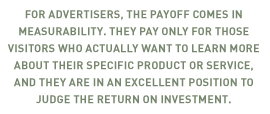Advertising Gets Personal
![]()
© Jack Cashill
April 2008
Courtesy of ingramsonline.com

Or, more ambitiously, back in the days when you could still smoke in bars—remember those?— “personalized” might have meant putting the name of your tavern on the matchbooks you handed out with the ashtrays.
Not anymore.
Now “personalized” describes a brave new advertising future that is equal parts Ogilvy and Orwell, Huxley and The Hucksters, and no one quite knows where it will all end up.
If this trend has a guru—doesn’t every trend?— it would have to be Google CEO, Eric Schmidt. In a semi-famous July 2006 conference call, Schmidt laid out his vision for advertising’s future.
“People are in their cars,” said Schmidt, only a little hyperbolically. “Why doesn’t the car give you an ad that says, ‘Eric, you need new pants. There is a pants store to the left?’”
As Schmidt explained, “The car has a GPS. The radio knows where it is. The owner of the car is typically the driver. This is possible.”

Personalized advertising advocates like Schmidt have only scorn for traditional advertising and its inefficiencies, particularly television advertising.
Until a generation ago, viewers in most markets had a choice of only two or three TV shows at a given time slot. Viewers of a general audience program like, say, the Ed Sullivan Show, might watch ads for a dozen different products—from cigarettes to Studebakers—none of which held the slightest interest for them.
With the growth of cable TV, and the ability of cable companies to segment audiences geographically, advertisers were better able to “target” their potential customers by age, location, education, and a variety of what are called psychographic, or lifestyle, variables.
Thus, for instance, the New Yorker Magazine would know enough not to advertise its product on The Jerry Springer Show. People Magazine, however, might feel otherwise.
Schmidt sees even so-called “targeted” advertising as a waste of the advertiser’s dollars and the consumer’s time. In the above example, for instance, for some unhealthy portion of the Springer audience, People Magazine might as well be War and Peace. They don’t read at all and have no interest in the ads.
Although it would be difficult to summarize the range of personalized possibilities now available, a glimpse at Google’s own advertising programs might give some useful insight.
Not surprisingly, Google is pioneering the personalized future. To learn how Google advertising works, one need only Google “How Google Advertising Works,” a wonderfully self-referential way to get started.
Google has two basic advertising programs. One, called “Adsense,” is designed for webmasters and website owners. The other, called “Adwords,” is designed for advertisers, as a way to connect them with their target audience, regardless of what it is that they are selling.
As it works, Adsense allows webmasters to earn money by having Google place relevant ads on their websites. Google recruits the advertisers from among those who have signed up for the Adword program.
The Adword participants select keywords and topics that match the product or service they are selling. They then bid on those keywords by citing the price that they would be willing to pay. They can pay either by click or by thousand “impressions”— that is views of the webpage.
For those webmasters in the Adsense program, Google will match their topic material with the pool of keywords that advertisers have submitted. The webmasters also get to designate what kind of ads they would like to display on their sites.
 And then as Google says, “Voila!” That simple. Ads appear on the Adsense member’s website. When viewers visit
the relevant page of the web site—per thousand impressions ads—or click on a link—per click ads—Google deposits
money into their account.
And then as Google says, “Voila!” That simple. Ads appear on the Adsense member’s website. When viewers visit
the relevant page of the web site—per thousand impressions ads—or click on a link—per click ads—Google deposits
money into their account.
To be sure, Google has programs that track what it calls “suspicious clicks.” So webmasters run the risk of being arrested for fraud if they try to pump the ads on their site. If, however, they are able to generate genuine traffic, they can begin to make real money.
For the advertiser, the payoff comes in measurability. Especially on a perclick basis, they pay only for those visitors who actually want to learn more about their specific product or service, and they are in an excellent position to judge the return on investment.
For Schmidt and other adventurous souls, the challenge now is to apply the highly efficient measurability of Internet advertising to more traditional media, and this is being done as we speak.
As one might imagine, personalized advertising has its critics. At Ingram’s recent Industry Outlook meeting, no one summarized the potential reaction against this form of advertising better than John January, of Sullivan, Higdon & Sink.
“I think there is a fine line between personalization and creepy.

